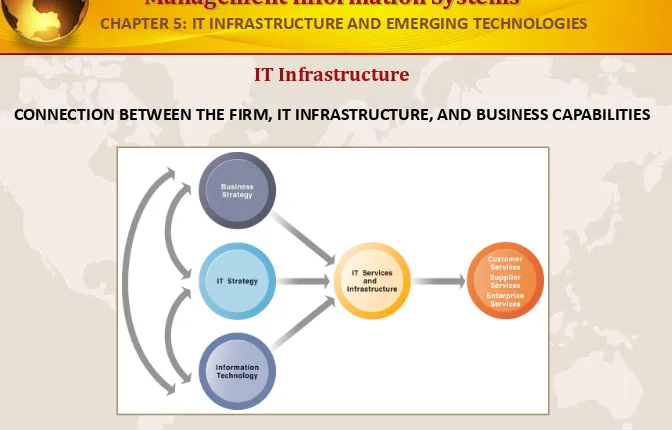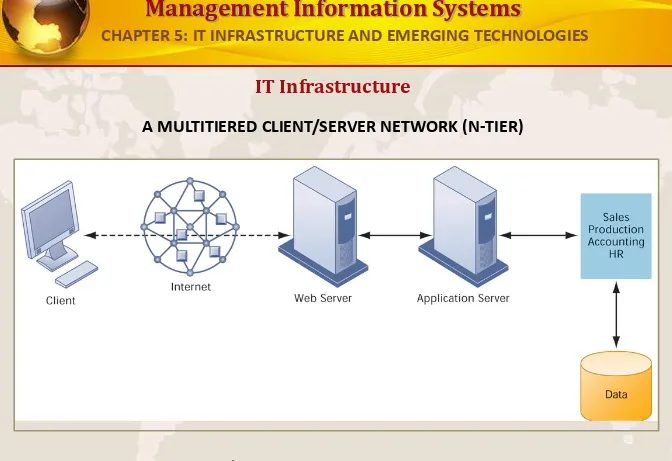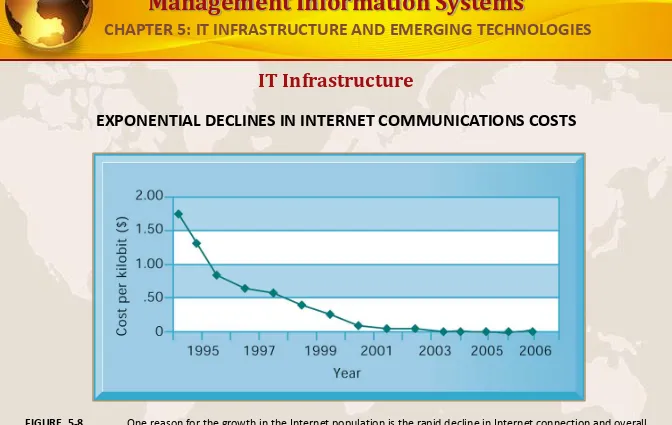Management Information Systems
MANAGING THE DIGITAL FIRM, 12THEDITION GLOBAL EDITION
IT INFRASTRUCTURE AND
EMERGING TECHNOLOGIES
Chapter 5
VIDEO CASES
Management Information Systems
•
Define IT infrastructure and describe its
components.
•
Identify and describe the stages and technology
drivers of IT infrastructure evolution.
•
Assess contemporary computer hardware platform
trends.
•
Assess contemporary software platform trends.
•
Evaluate the challenges of managing IT
Learning Objectives
Management Information Systems
CHAPTER 5: IT INFRASTRUCTURE AND EMERGING TECHNOLOGIES
•
Problem:
Aging systems no longer able to provide
information rapidly enough for timely decisions; too
unreliable for 24/7 operations
•
Solutions:
Replaced and upgraded hardware and software
and used leading-edge technology
–
Grid computing
–
Virtualization
–
Blade servers
•
Demonstrates IT’s role in using resources more efficiently;
Management Information Systems
•
IT infrastructure:
–
Set of physical devices and software required to
operate enterprise
–
Set of firmwide services including:
• Computing platforms providing computing services
• Telecommunications services
• Data management services
• Application software services
• Physical facilities management services
• IT management, standards, education, research and development services
IT Infrastructure
Management Information Systems
IT Infrastructure
CONNECTION BETWEEN THE FIRM, IT INFRASTRUCTURE, AND BUSINESS CAPABILITIES
The services a firm is capable of providing to its customers, suppliers, and employees are a direct function
FIGURE 5-1
Management Information Systems
CHAPTER 5: IT INFRASTRUCTURE AND EMERGING TECHNOLOGIES
•
Evolution of IT infrastructure
– General-purpose mainframe & minicomputer era: 1959 to present
• 1958 IBM first mainframes introduced
• 1965 Less expensive DEC minicomputers introduced – Personal computer era: 1981 to present
• 1981 Introduction of IBM PC
• Proliferation in 80s, 90s resulted in growth of personal software – Client/server era: 1983 to present
• Desktop clients networked to servers, with processing work split between clients and servers
Management Information Systems
IT Infrastructure
STAGES IN IT
INFRASTRUCTURE EVOLUTION
Illustrated here are the typical computing configurations characterizing each of the five eras of IT infrastructure evolution.
FIGURE 5-2
Management Information Systems
•
Evolution of IT infrastructure (cont.)
–
Enterprise computing era: 1992 to present
• Move toward integrating disparate networks,
applications using Internet standards and enterprise applications
–
Cloud Computing: 2000 to present
• Refers to a model of computing where firms and individuals obtain computing power and software applications over the Internet or other network
• Fastest growing form of computing
IT Infrastructure
Management Information Systems
IT Infrastructure
STAGES IN IT
INFRASTRUCTURE EVOLUTION (cont.)
Illustrated here are the typical computing configurations characterizing each of the five eras of IT infrastructure evolution.
FIGURE 5-2
Management Information Systems
IT Infrastructure
A MULTITIERED CLIENT/SERVER NETWORK (N-TIER)
Management Information Systems
•
Technology drivers of infrastructure evolution
–
Moore’s law and microprocessing power
•
Computing power doubles every 18 months
•
Nanotechnology:
– Shrinks size of transistors to size comparable to size of a virus
–
Law of Mass Digital Storage
•
The amount of data being stored each year
doubles
IT Infrastructure
Management Information Systems
IT Infrastructure
MOORE’S LAW AND
MICROPROCESSOR PERFORMANCE
Packing over 2 billion transistors into a tiny microprocessor has exponentially increased processing power. Processing power has increased to over 500,000 MIPS (millions of instructions per second).
FIGURE 5-4
Management Information Systems
IT Infrastructure
FALLING COST OF CHIPS
Packing more transistors into less space has driven down transistor cost dramatically as well as the cost of the
products in which they are used.
FIGURE 5-5
Management Information Systems
IT Infrastructure
EXAMPLES OF NANOTUBES
Nanotubes are tiny tubes about 10,000 times thinner than a human hair. They consist of rolled up sheets of carbon hexagons and have potential uses as minuscule wires or in ultrasmall electronic devices and are very powerful conductors of electrical current.
FIGURE 5-6
Management Information Systems
IT Infrastructure
THE COST OF STORING DATA DECLINES
EXPONENTIALLY 1950–2010
Since the first magnetic storage device was used in 1955, the cost of storing a kilobyte of data has fallen exponentially, doubling the amount of digital storage for each dollar
expended every 15 months, on average.
FIGURE 5-7
Management Information Systems
•
Technology drivers of infrastructure evolution
(cont.)
–
Metcalfe’s Law and network economics
•
Value or power of a network grows
exponentially as a function of the number of
network members
•
As network members increase, more people
want to use it (demand for network access
increases)
IT Infrastructure
Management Information Systems
•
Technology drivers of infrastructure evolution
(cont.)
–
Declining communication costs and the Internet
•
An estimated 1.5 billion people worldwide have
Internet access
•
As communication costs fall toward a very small
number and approach 0, utilization of
communication and computing facilities
explodes
IT Infrastructure
Management Information Systems
IT Infrastructure
EXPONENTIAL DECLINES IN INTERNET COMMUNICATIONS COSTS
One reason for the growth in the Internet population is the rapid decline in Internet connection and overall
FIGURE 5-8
Management Information Systems
•
Technology drivers of infrastructure evolution
(cont.)
–
Standards and network effects
•
Technology standards:
– Specifications that establish the compatibility of products and the ability to communicate in a network
– Unleash powerful economies of scale and result in price declines as manufacturers focus on the
IT Infrastructure
Management Information Systems
•
IT Infrastructure has 7 main components
1. Computer hardware platforms
2. Operating system platforms
3. Enterprise software applications
4. Data management and storage
5. Networking/telecommunications platforms
6. Internet platforms
7. Consulting system integration services
Infrastructure Components
Management Information Systems
IT Infrastructure
THE IT
INFRASTRUCTURE ECOSYSTEM
There are seven major components that must be coordinated to provide the firm with a coherent IT
infrastructure. Listed here are major technologies and suppliers for each component.
FIGURE 5-9
Management Information Systems
•
Computer hardware platforms
–
Client machines
• Desktop PCs, mobile devices – PDAs, laptops
–
Servers
• Blade servers: ultrathin computers stored in racks
–
Mainframes:
• IBM mainframe equivalent to thousands of blade servers
–
Top chip producers: AMD, Intel, IBM
Infrastructure Components
Management Information Systems
•
Operating system platforms
–
Operating systems
• Server level: 75% run Windows; 25% run Unix or Linux
• Client level:
– 90% run Microsoft Windows (XP, 2000, CE, etc.)
– Handheld device OS’s (Android, iPhone OS)
– Cloud computing OS’s (Google’s Chrome OS)
•
Enterprise software applications
–
Enterprise application providers: SAP and Oracle
Infrastructure Components
Management Information Systems
Read the Interactive Session and discuss the following questions
• What problems does multitouch technology solve?
• What are the advantages and disadvantages of a multitouch interface? How useful is it? Explain.
• Describe three business applications that would benefit from a multitouch interface.
• What management, organization, and technology issues must be addressed if you or your business was considering
Infrastructure Components
NEW TO THE TOUCH
Management Information Systems
•
Data management and storage
–
Database software:
•
IBM (DB2), Oracle, Microsoft (SQL Server),
Sybase (Adaptive Server Enterprise), MySQL
–
Physical data storage:
•
EMC Corp (large-scale systems), Seagate,
Maxtor, Western Digital
–
Storage area networks (SANs):
•
Connect multiple storage devices on dedicated
Infrastructure Components
Management Information Systems
•
Networking/telecommunications platforms
–
Telecommunication services
•
Telecommunications, cable, telephone
company charges for voice lines and Internet
access
•
AT&T, Verizon
–
Network operating systems:
•
Windows Server, Novell, Linux, Unix
–
Network hardware providers:
Infrastructure Components
Management Information Systems
•
Internet platforms
–
Hardware, software, management services to
support company Web sites, (including Web
hosting services) intranets, extranets
–
Internet hardware server market: Dell,
HP/Compaq, IBM
–
Web development tools/suites: Microsoft
(FrontPage, .NET) IBM (WebSphere) Sun (Java),
independent software developers: Adobe,
Infrastructure Components
Management Information Systems
•
Consulting and system integration services
–
Even large firms do not have resources for a full
range of support for new, complex infrastructure
–
Software integration: ensuring new
infrastructure works with legacy systems
–
Legacy systems: older TPS created for
mainframes that would be too costly to replace
or redesign
–
Accenture, IBM Global Services, EDS, Infosys,
Infrastructure Components
Management Information Systems
•
The emerging mobile digital platform
–
Cell phones, smartphones (BlackBerry, iPhone)
•
Have assumed data transmission, Web surfing,
e-mail and IM duties
–
Netbooks:
•
Small, low-cost lightweight notebooks
optimized for wireless communication and core
computing tasks
–
Tablets (iPad)
Contemporary Hardware Platform Trends
Management Information Systems
•
Grid computing
–
Connects geographically remote computers into a
single network to combine processing power and
create virtual supercomputer
–
Provides cost savings, speed, agility
•
Virtualization
–
Allows single physical resource to act as multiple
resources (i.e., run multiple instances of OS)
–
Reduces hardware and power expenditures
Contemporary Hardware Platform Trends
Management Information Systems
•
Cloud computing
–
On-demand (utility) computing services obtained
over network
• Infrastructure as a service
• Platform as a service
• Software as a service
–
Cloud can be public or private
–
Allows companies to minimize IT investments
–
Drawbacks: Concerns of security, reliability
Contemporary Hardware Platform Trends
Management Information Systems
•
Green computing
– Practices and technologies for manufacturing, using, disposing of computing and networking hardware
•
Autonomic computing
– Industry-wide effort to develop systems that can configure, heal themselves when broken, and protect themselves
from outside intruders
– Similar to self-updating antivirus software; Apple and Microsoft both use automatic updates
•
High performance, power-saving processors
Contemporary Hardware Platform Trends
Management Information Systems
Read the Interactive Session and discuss the following questions
•
What business and social problems does data
center power consumption cause?
•
What solutions are available for these problems?
Which are environment-friendly?
•
What are the business benefits and costs of these
solutions?
•
Should all firms move toward green computing?
Contemporary Hardware Platform Trends
NORDEA GOES GREEN WITH IT
Management Information Systems
•
Linux and open-source software
–
Open-source software: Produced by community of
programmers, free and modifiable by user
–
Linux: Open-source software OS
•
Software for the Web
–
Java:
• Object-oriented programming language
• Operating system, processor-independent
–
Ajax
• Asynchronous JavaScript and XML
•
Contemporary Software Platform Trends
Management Information Systems
•
Web Services
– Software components that exchange information using Web standards and languages
– XML: Extensible Markup Language
• More powerful and flexible than HTML
• Tagging allows computers to process data automatically – SOAP: Simple Object Access Protocol
• Rules for structuring messages enabling applications to pass data and instructions
– WSDL: Web Services Description Language
• Framework for describing Web service and capabilities
– UDDI: Universal Description, Discovery, and Integration
Contemporary Software Platform Trends
Management Information Systems
•
SOA: Service-oriented architecture
–
Set of self-contained services that communicate with
each other to create a working software application
–
Software developers reuse these services in other
combinations to assemble other applications as
needed
• Example: an “invoice service” to serve whole firm for
calculating and sending printed invoices
–
Dollar Rent A Car
•
Contemporary Software Platform Trends
Management Information Systems
Contemporary Software Platform Trends
HOW DOLLAR RENT A CAR USES WEB SERVICES
Management Information Systems
•
Software outsourcing and cloud services
–
Three external sources for software:
1. Software packages and enterprise software 2. Software outsourcing (domestic or offshore)
– Domestic:
» Primarily for middleware, integration services, software support
– Offshore:
» Primarily for lower level maintenance, data entry, call centers, although outsourcing for new-program
Contemporary Software Platform Trends
Management Information Systems
•
Three external sources for software (cont.)
3. Cloud-based software services
• Software as a service (SaaS)
• Accessed with Web browser over Internet
• Ranges from free or low-cost services for individuals to business and enterprise software
• Users pay on subscription or per-transaction
• E.g. Salesforce.com
• Service Level Agreements (SLAs): formal agreement with service providers
Contemporary Software Platform Trends
Management Information Systems
Contemporary Software Platform Trends
CHANGING
SOURCES OF FIRM SOFTWARE
In 2010, U.S. firms will spend over $265 billion on software. About 40 percent of that ($106 billion) will originate outside the firm, either from enterprise software vendors selling
firmwide applications or individual application service providers leasing or selling software modules. Another 10 percent ($10 billion) will be provided by SaaS vendors as an online cloud-based service.
FIGURE 5-11
Management Information Systems
•
Software outsourcing and cloud services (cont.)
– Mashups• Combinations of two or more online applications, such as combining mapping software (Google Maps) with local content
– Apps
• Small pieces of software that run on the Internet, on your computer, or on your cell phone
– iPhone, BlackBerry, Android
• Generally delivered over the Internet
Contemporary Software Platform Trends
Management Information Systems
•
Dealing with platform and infrastructure change
– As firms shrink or grow, IT needs to be flexible andscalable – Scalability:
• Ability to expand to serve larger numbers of users
– For mobile computing and cloud computing
• New policies and procedures for managing these new platforms
• Contractual agreements with firms running clouds and distributing software required
Management Issues
Management Information Systems
•
Management and governance
–
Who controls IT infrastructure?
–
How should IT department be organized?
• Centralized
– Central IT department makes decisions
• Decentralized
– Business unit IT departments make own decisions
–
How are costs allocated between
divisions, departments?
Management Issues
Management Information Systems
•
Making wise infrastructure investments
–
Amount to spend on IT is complex question
• Rent vs. buy, outsourcing
–
Total cost of ownership (TCO) model
• Analyzes direct and indirect costs
• Hardware, software account for only about 20% of TCO
• Other costs: Installation, training, support,
maintenance, infrastructure, downtime, space and energy
• TCO can be reduced through use of cloud services,
Management Issues
Management Information Systems
•
Competitive forces model for IT
infrastructure investment
1.
Market demand for firm’s services
2.
Firm’s business strategy
3.
Firm’s IT strategy, infrastructure, and cost
4. Information technology assessment
5. Competitor firm services
6. Competitor firm IT infrastructure investments
Management Issues
Management Information Systems
Management Issues
COMPETITIVE FORCES MODEL FOR IT INFRASTRUCTURE
Management Information Systems
All rights reserved. No part of this publication may be reproduced, stored in a retrieval system, or transmitted, in any form or by any means, electronic, mechanical, photocopying, recording, or otherwise, without the
prior written permission of the publisher.
Printed in the United States of America.
Copyright © 2012 Pearson Education









